A look at the winners from this year's Astronomy photographer of the year competition
held by the National Maritime Museum. Amateur astronomer Damian Peach became
the first Briton to win the title, beating off hundreds of photographers to the coveted prize.
held by the National Maritime Museum. Amateur astronomer Damian Peach became
the first Briton to win the title, beating off hundreds of photographers to the coveted prize.

1: Runner-up (Earth & Space), 'Divine Presence' by Ole C. Salomonsen (Norway).
Display of the Aurora Borealis, or Northern Lights, taken over ponds near Hillesøy in Norway, 11 March 2011.
The aurorae are caused by the interaction between the Earth's atmosphere and a stream of particles from the Sun
known as the solar wind. The Earth's magnetic field funnels these particles down over the planet's poles giving
rise to the glowing curtains of coloured light
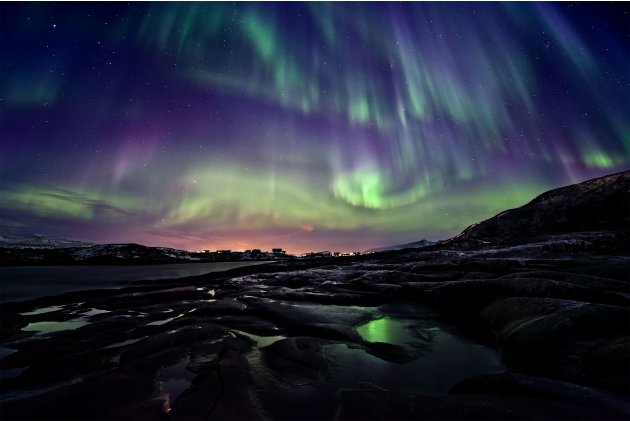
2: Runner-up (Young Astronomer) 'Starry Night Sky' by Nicole Sullivan (USA, age 15)
Star trails above the Sierra Nevada mountain range on 30 June 2011.
The long exposure captures how the stars appear to circle the Pole Star as the Earth rotates on its axis.
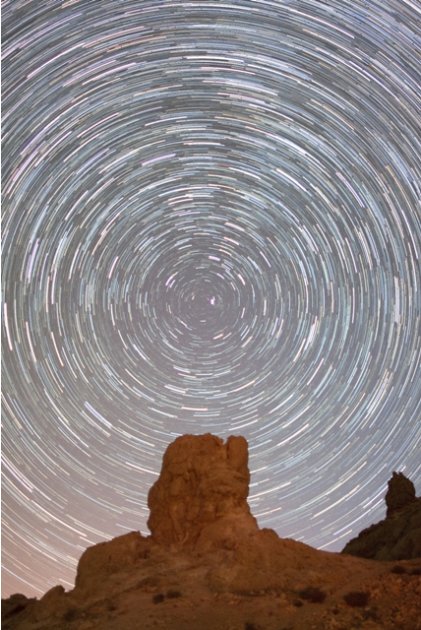
3: Winner (Deep Space) 'Vela Supernova Remnant' by Marco Lorenzi (Italy)
The intricate structure of the aftermath of a supernova explosion - the violent death of a star
many times more massive than the Sun which took place over 10,000 years ago.
Seen against stars and gas in the disc of our Milky Way, this expanding shell of debris and heated gas
now covers an area of the sky which is twenty times bigger than the disc of the full Moon.
The intricate structure of the aftermath of a supernova explosion - the violent death of a star
many times more massive than the Sun which took place over 10,000 years ago.
Seen against stars and gas in the disc of our Milky Way, this expanding shell of debris and heated gas
now covers an area of the sky which is twenty times bigger than the disc of the full Moon.
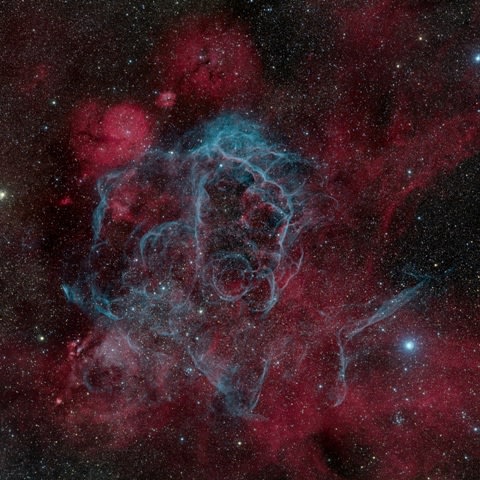
4: Highly Commended (Earth and Space) 'Volcanic Aurora' by Örvar Atli Þorgeirsson (Iceland)
A shimmering aurora, resulting from magnetic activity on the Sun, provides a spectacular background
to a dramatic eruption of the Eyjafjallajökull volcano. A dark cloud of ash at ground level can be seen
to the left in this photograph, while there is bright red lava at the mouth of the volcano.
The eruption caused substantial disruption to international travel in the spring of 2010
A shimmering aurora, resulting from magnetic activity on the Sun, provides a spectacular background
to a dramatic eruption of the Eyjafjallajökull volcano. A dark cloud of ash at ground level can be seen
to the left in this photograph, while there is bright red lava at the mouth of the volcano.
The eruption caused substantial disruption to international travel in the spring of 2010
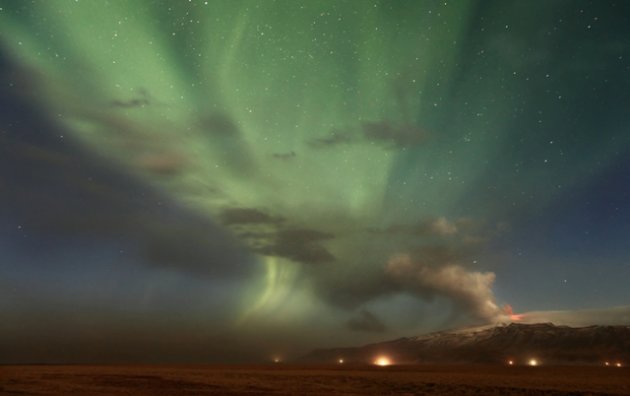
5: Winner (Solar System) and Overall Winner 'Jupiter with Io and Ganymede' by Damian Peach (UK)
Jupiter depicted along with two of its 64 known moons, Io and Ganymede, showing the surface of the
gas giant streaked with colourful bands and dotted with huge oval storms; detail is also visible on the two moons.
The photos which make up this composite image were taken from Barbados where the excellent atmospheric clarity
allows for exceptionally clear astronomical pictures.
Jupiter depicted along with two of its 64 known moons, Io and Ganymede, showing the surface of the
gas giant streaked with colourful bands and dotted with huge oval storms; detail is also visible on the two moons.
The photos which make up this composite image were taken from Barbados where the excellent atmospheric clarity
allows for exceptionally clear astronomical pictures.

6: Highly Commended (Deep Space) 'Orion, Head to Toe' by Rogelio Bernal Andreo (USA)
The bright stars of the Orion constellation seen within a skyscape of fainter stars, gas and dust,
which is invisible to the naked eye. Orion is laid out from left to right in this photograph while
a huge cloud of gas and dust in which new stars are forming lies below the three stars of Orion's belt;
bright red and blue supergiant stars mark his shoulder and knee. The long exposure time and use of special
filters allows us to see the hidden beauty behind this familiar constellation.
The bright stars of the Orion constellation seen within a skyscape of fainter stars, gas and dust,
which is invisible to the naked eye. Orion is laid out from left to right in this photograph while
a huge cloud of gas and dust in which new stars are forming lies below the three stars of Orion's belt;
bright red and blue supergiant stars mark his shoulder and knee. The long exposure time and use of special
filters allows us to see the hidden beauty behind this familiar constellation.
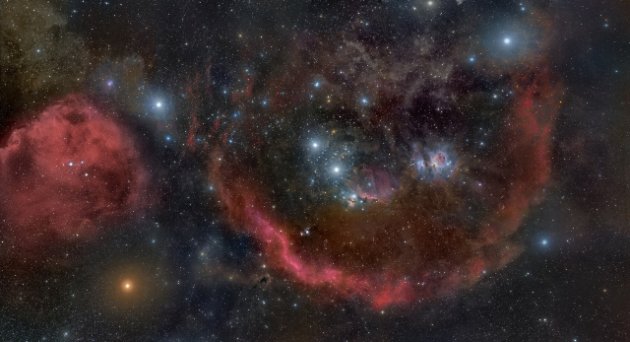
7: Winner (Earth & Space) 'Galactic Paradise' by Tunç Tezel (Turkey).
The southern Milky Way viewed over the hilltops lined with palm trees just outside the village of
Oneroa on the coast of Mangaia in the Cook Islands, 11 July 2010. The Milky Way galaxy contains
hundreds of billions of stars in a disc-like structure and this Southern Hemisphere view highlights
dark clouds of dust that aboriginal Australian astronomers called the 'Emu in the sky'.
The panorama was made using nine 30 second exposures and the humidity and moisture created
the diffusion and colour effects on the stars.
The southern Milky Way viewed over the hilltops lined with palm trees just outside the village of
Oneroa on the coast of Mangaia in the Cook Islands, 11 July 2010. The Milky Way galaxy contains
hundreds of billions of stars in a disc-like structure and this Southern Hemisphere view highlights
dark clouds of dust that aboriginal Australian astronomers called the 'Emu in the sky'.
The panorama was made using nine 30 second exposures and the humidity and moisture created
the diffusion and colour effects on the stars.
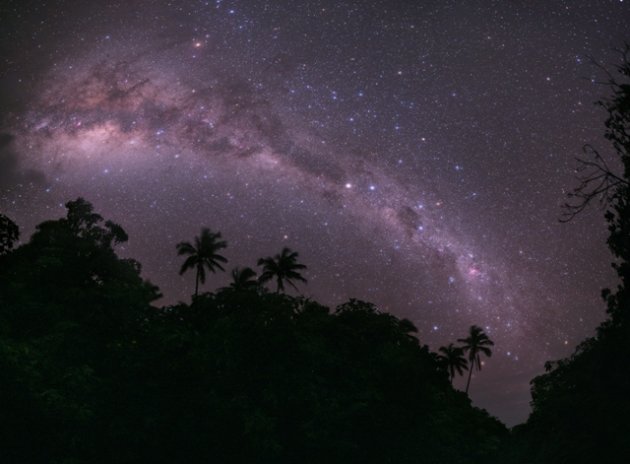
8: Highly Commended (Deep Space) 'Fighting Dragons of Ara' by Michael Sidonio (Australia)
Clouds of swirling purple, green and orange gas and dust that appear as 'fighting dragons',
shaped by the recent birth of large stars much bigger and brighter than our Sun.
One such star can be seen to the lower left of the image within two shells of glowing gas.
The image gives a snapshot of the chaotic stellar nurseries in which stars are born.
Our own Sun probably formed in similar circumstances 4.5 billion years ago
Clouds of swirling purple, green and orange gas and dust that appear as 'fighting dragons',
shaped by the recent birth of large stars much bigger and brighter than our Sun.
One such star can be seen to the lower left of the image within two shells of glowing gas.
The image gives a snapshot of the chaotic stellar nurseries in which stars are born.
Our own Sun probably formed in similar circumstances 4.5 billion years ago
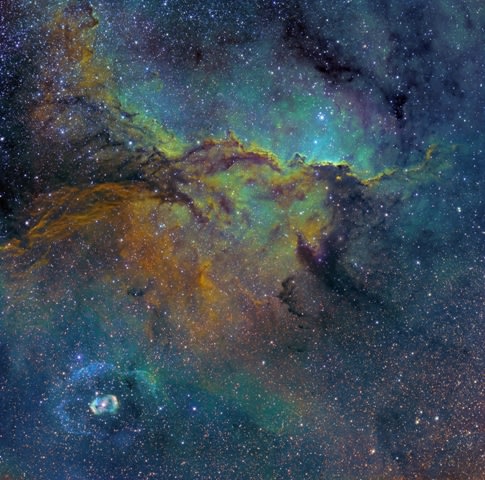
9: Runner-up (People and Space) Hunting Moon by Jean-Baptiste Feldmann (France)
A playful silhouette places an Earth-bound Moon-catcher in pursuit of the waxing crescent Moon
in the early evening sky on 6 April 2011. The bright crescent is the part of the Moon lit directly by the
Sun which is visible from Earth. The rest of the face of the Moon is also visible, although much fainter
owing to reflected light from the Earth, known as earthshine.
To actually reach the Moon the net would need to be 380,000 km long
A playful silhouette places an Earth-bound Moon-catcher in pursuit of the waxing crescent Moon
in the early evening sky on 6 April 2011. The bright crescent is the part of the Moon lit directly by the
Sun which is visible from Earth. The rest of the face of the Moon is also visible, although much fainter
owing to reflected light from the Earth, known as earthshine.
To actually reach the Moon the net would need to be 380,000 km long

10: Highly commended (Young Astronomer) 'Lonely Moon' by Peter Pihlmann Pedersen (UK, age 15)
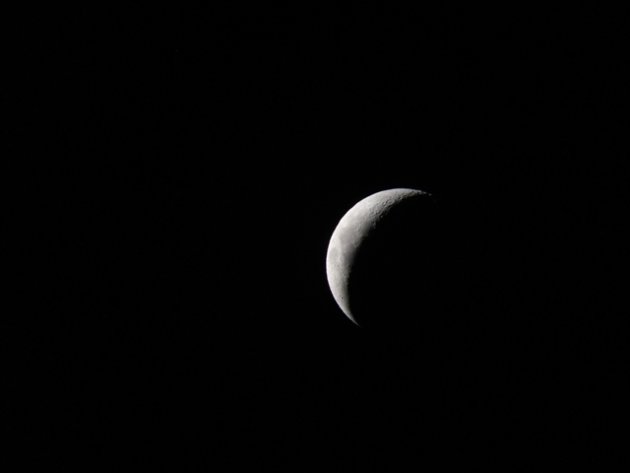
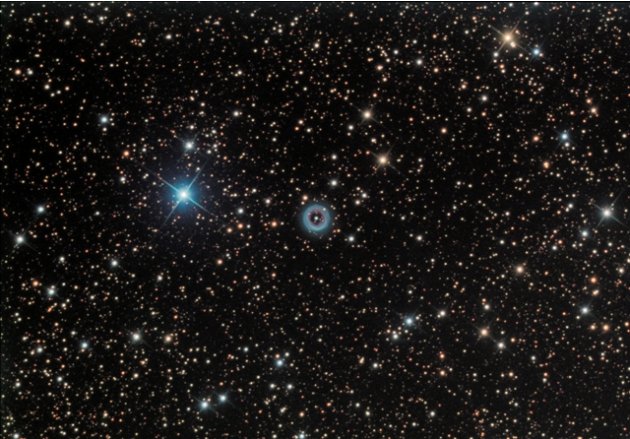
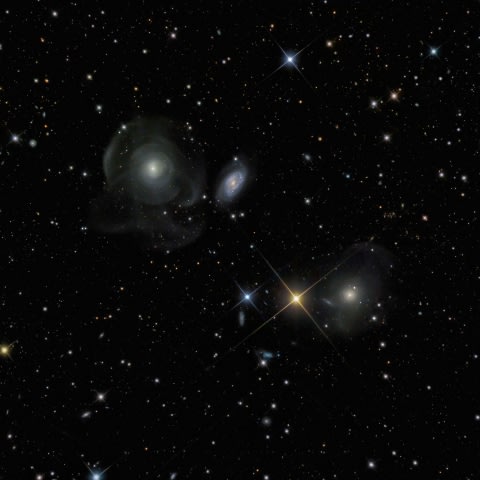
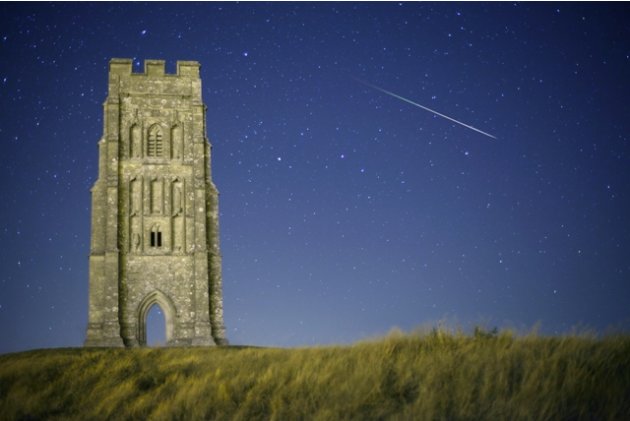
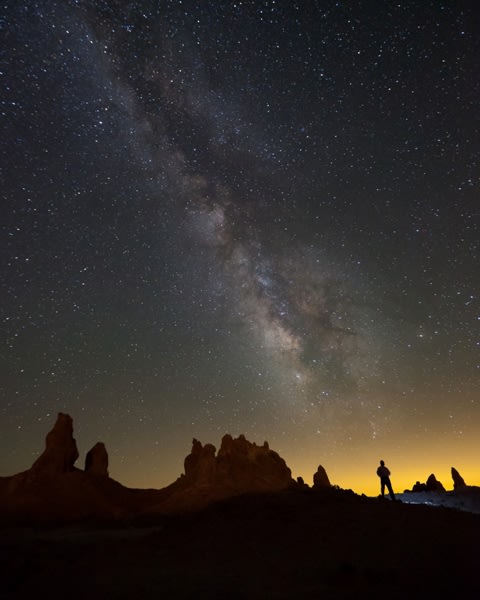

A crescent Moon photographed on 9 March 2011. Like the Earth, one half of the Moon is always lit by the Sun.
It is the relative positions of the Earth, Moon and Sun that determine how much of this illuminated side we see from the Earth.

11:Highly Commended (Deep Space) 'Planetary Nebula Shapley 1' by Steve Crouch (Australia)
Planetary nebulae, Shapley 1, photographed on 28 May 2011. When viewed through a small telescope
planetary nebulae resemble nearby planets in our Solar System, but they are in fact distant regions of hot,
glowing gas ejected by stars as they run out of fuel at the end of their lives.
The colours visible in the ring are caused by the temperature and chemical composition of the material this
dying star has returned to its environment.
Planetary nebulae, Shapley 1, photographed on 28 May 2011. When viewed through a small telescope
planetary nebulae resemble nearby planets in our Solar System, but they are in fact distant regions of hot,
glowing gas ejected by stars as they run out of fuel at the end of their lives.
The colours visible in the ring are caused by the temperature and chemical composition of the material this
dying star has returned to its environment.

12: Winner (Robotic Telescope) 'Shell Galaxies' by Marco Lorenzi (Italy) Three distant galaxies located
in the constellation of Pisces. In the upper left of this photograph, faint billowing shapes can be seen
in the outer regions of an elliptical galaxy. Elliptical galaxies, which can contain up to a trillion stars,
are typically smooth and shaped like a rugby ball. The delicate wispy shells surrounding this galaxy may result
from a gravitational interaction with the nearby spiral galaxy to the right which has disturbed the
orbits of its outermost stars.
in the constellation of Pisces. In the upper left of this photograph, faint billowing shapes can be seen
in the outer regions of an elliptical galaxy. Elliptical galaxies, which can contain up to a trillion stars,
are typically smooth and shaped like a rugby ball. The delicate wispy shells surrounding this galaxy may result
from a gravitational interaction with the nearby spiral galaxy to the right which has disturbed the
orbits of its outermost stars.

13: Highly commended (Earth & Space) 'Somerset: Meteor at Midnight, Glastonbury Tor' by Mike Kempsey (UK)
A meteor captured streaking across the sky by Glastonbury Tor in Somerset on 12 August 2010 at the peak of the
annual Perseid meteor shower. The Perseids is one of the most prolific showers, often with around 80 meteors an hour
during its peak. Nevertheless, meteors are hard to catch on camera: the photographer has used a continuous
shooting mode so that the camera was photographing non-stop in order to catch this fleeting image.
A meteor captured streaking across the sky by Glastonbury Tor in Somerset on 12 August 2010 at the peak of the
annual Perseid meteor shower. The Perseids is one of the most prolific showers, often with around 80 meteors an hour
during its peak. Nevertheless, meteors are hard to catch on camera: the photographer has used a continuous
shooting mode so that the camera was photographing non-stop in order to catch this fleeting image.

14: Winner (People and Space) 'Stargazing' by Jeffrey Sullivan (USA) A self-portrait of the photographer silhouetted
on a hilltop in the Sierra Nevada mountain range under the glittering band of the Milky Way, which contains hundreds of
billions of stars in a disc-like structure. Our Sun lies within the disc, about two-thirds of the way out from the centre,
so we see it as a bright band encircling the sky.




__._,_.___

No comments:
Post a Comment